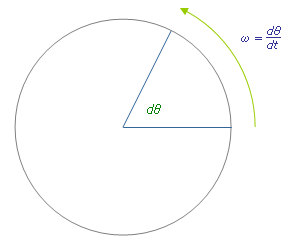Angular velocity facts for kids
In physics, angular velocity is a way to describe how fast an object is spinning or rotating, and also the direction it's spinning in. Think of it like the speed of a car, but for things that turn!
It's a special type of measurement called a vector. This means it has both a size (how fast) and a direction. The standard unit for angular velocity is radians per second. But you might also hear it measured in other ways, like degrees per second, or even revolutions per minute (RPM) for things like car engines or record players. When it's measured in rotations per minute, it's often called rotational velocity.
Scientists usually use the Greek letter omega (Ω or ω) to stand for angular velocity. The direction of this spinning motion is often found using something called the right-hand rule. This rule helps you figure out the exact direction of the angular velocity vector, which is always straight out from the flat surface where the spinning happens.
Contents
What is Angular Velocity?
Angular velocity helps us understand how quickly an object turns around a central point or axis. Imagine a spinning top or a merry-go-round. Angular velocity tells you not just how fast it's going around, but also which way it's turning.
For example, if you're on a Ferris wheel, your angular velocity describes how fast the wheel is rotating and whether it's going clockwise or counter-clockwise. It's super important in understanding how planets orbit, how gears work in machines, and even how athletes perform spins.
Measuring Spin: Units and Symbols
We measure angular velocity using specific units. The most common unit is radians per second. A radian is a way to measure angles, just like degrees.
- Radians per second (rad/s): This is the official unit in the SI system. It tells you how many radians an object turns in one second.
- Degrees per second (°/s): Sometimes, especially in everyday life, people might talk about degrees per second. A full circle is 360 degrees.
- Revolutions per minute (RPM): This unit is very common for engines and motors. One revolution means a full spin around. So, 100 RPM means something spins around 100 times in one minute.
The symbol for angular velocity is the Greek letter omega. It looks like a fancy 'W' (Ω) or a small 'w' (ω).
Direction of Spin: The Right-Hand Rule
Since angular velocity is a vector, it has a direction. But how do you show the direction of something that's spinning in a circle? We use a clever trick called the right-hand rule.
Here's how it works:
- Imagine you are holding the spinning object with your right hand.
- Curl your fingers in the direction the object is spinning (clockwise or counter-clockwise).
- Your thumb will then point in the direction of the angular velocity vector.
So, if something is spinning counter-clockwise, your thumb will point upwards. If it's spinning clockwise, your thumb will point downwards. This rule helps scientists and engineers easily understand the direction of rotation without drawing complicated diagrams.
Related pages
See also
 In Spanish: Velocidad angular para niños
In Spanish: Velocidad angular para niños


